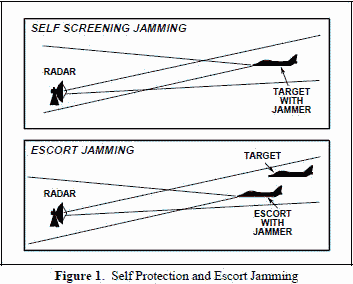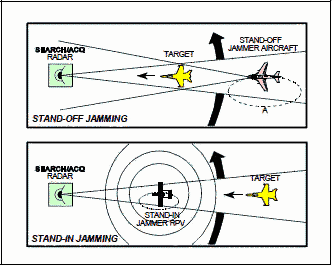 Khobai, on 22 April 2015 - 07:23 AM, said:
Khobai, on 22 April 2015 - 07:23 AM, said:
Except it doesnt work anything like real life. Real life ECM doesnt give an aircraft and all his squadron buddies stealth.
would effectively do just that.

- "Barrage jamming is using a wide noise bandwidth to cover several radars with one jammer or to compensate for any uncertainty in the radar frequency." - Electronic Warfare and Radar Systems Engineering Handbook, Fourth Edition (October 2013), pg. 4-9.2
- "BARRAGE NOISE JAMMING - Noise jamming spread in frequency to deny the use of multiple radar frequencies to effectively deny range information. Although this is attractive because it enables one jammer to simultaneously jam several radars of different frequencies, it does have the inherent problem that the wider the jamming spread, the less jamming power available per radar, i.e. the watts per MHz bandwidth is low." - Electronic Warfare and Radar Systems Engineering Handbook, Fourth Edition (October 2013), pg. 10-1.3
On top of that, there is the concept of Support Electronic Attack ("EA") operations.


"Support EA is electronic transmissions radiated from one platform and is used to protect other platforms or fulfill other mission requirements, like distraction or conditioning. Figure 2 illustrates two cases of support jamming protecting a striker - stand-off jamming (SOJ) and stand-in jamming (SIJ)."
"The bottom half of Figure 1 illustrates escort jamming which is a special case of support jamming. If the escort platform is sufficiently close to the target, the J-to-S calculations are the same as for self protection EA."
(
Electronic Warfare and Radar Systems Engineering Handbook, Fourth Edition (October 2013), pg. 4-7.2)
As such, being able to jam multiple opposing BattleMechs' radar systems with a single friendly Guardian suite (and, thus, rendering multiple friendly units covered by the same single Guardian suite) would be well within the realm of plausibility.
Likewise, Beagle's ability to overcome Guardian's jamming at close ranges (which is present under the advanced rules found in
Tactical Operations) would be an example of what is known as "burn-through".
- "The point where the radar power overcomes the jamming signal is known as burn-through." - Electronic Warfare and Radar Systems Engineering Handbook, Fourth Edition (October 2013), pg. 4-8.2
- "A radar can be designed with higher than necessary power for earlier burn-through on jamming targets. Naturally that would also have the added advantage of earlier detection of non-jamming targets as well." - Electronic Warfare and Radar Systems Engineering Handbook, Fourth Edition (October 2013), pg. 4-8.2
- "Burn-through Range (Monostatic) is the radar to target range where the target return signal (S) can first be detected through the jamming (J). It is usually the range when the J/S just equals the minimum effective J/S." - Electronic Warfare and Radar Systems Engineering Handbook, Fourth Edition (October 2013), pg. 4-8.3
- "Burn-through Range (Bistatic) occurs when J/S just equals the minimum effective J/S." - Electronic Warfare and Radar Systems Engineering Handbook, Fourth Edition (October 2013), pg. 4-8.5
Also, Guardian's Ghost Target mode (a third mode of operation described in TacOps, not (yet?) implemented in MWO) would be an example of a "Random Range Program (RANRAP)" - "a dynamic False Target Jamming technique program to create multiple realistic targets of varying size and distance from the jamming plane."

Edited by Strum Wealh, 22 April 2015 - 12:52 PM.
 Bush Hopper, on 22 April 2015 - 07:36 AM, said:
Bush Hopper, on 22 April 2015 - 07:36 AM, said:

































